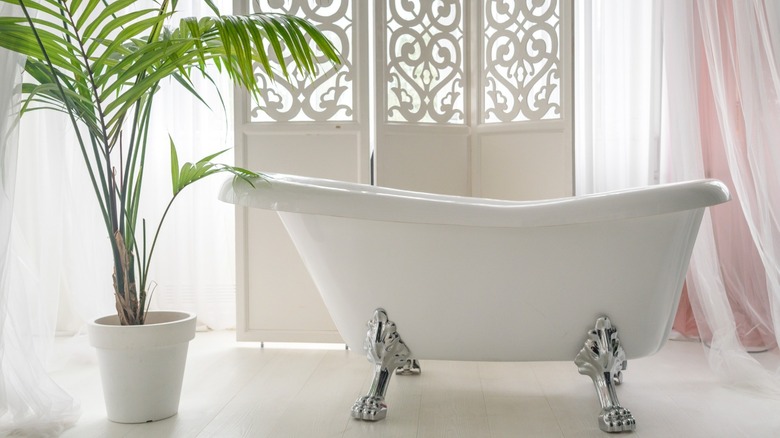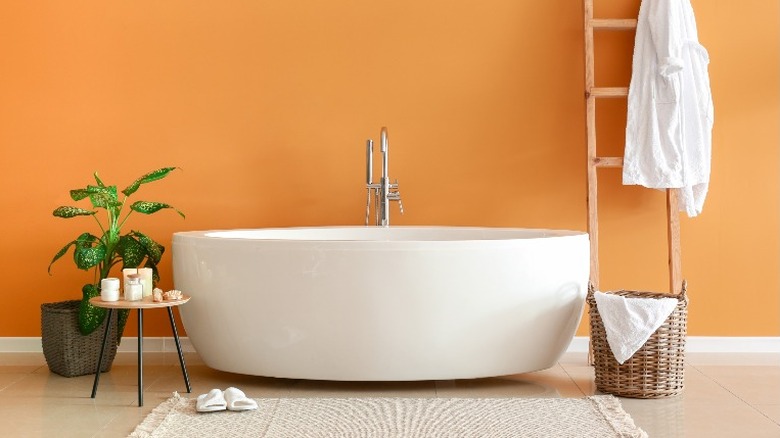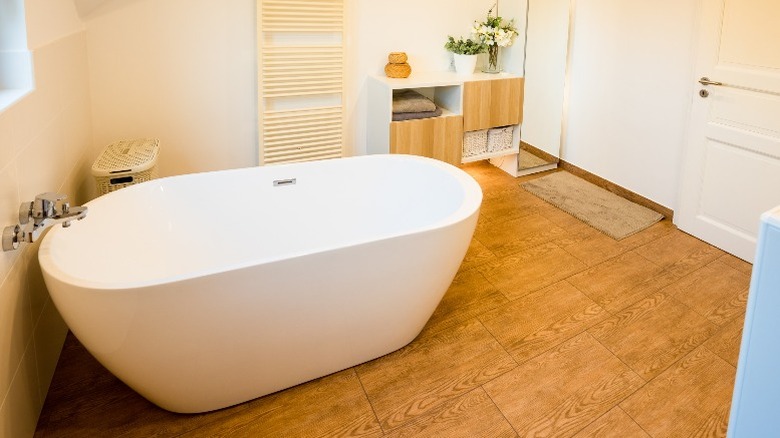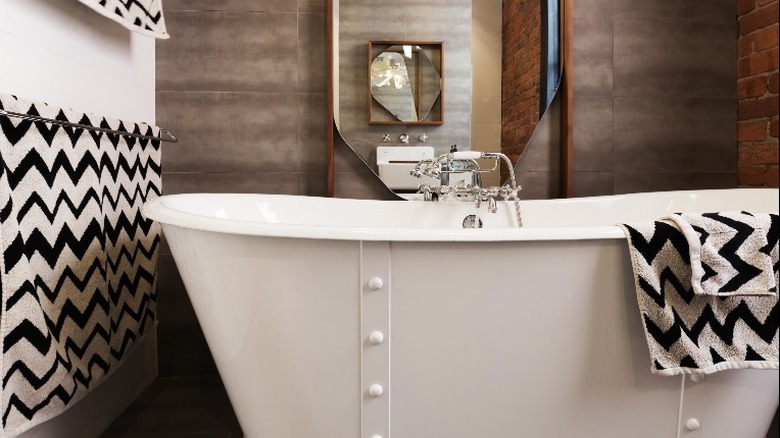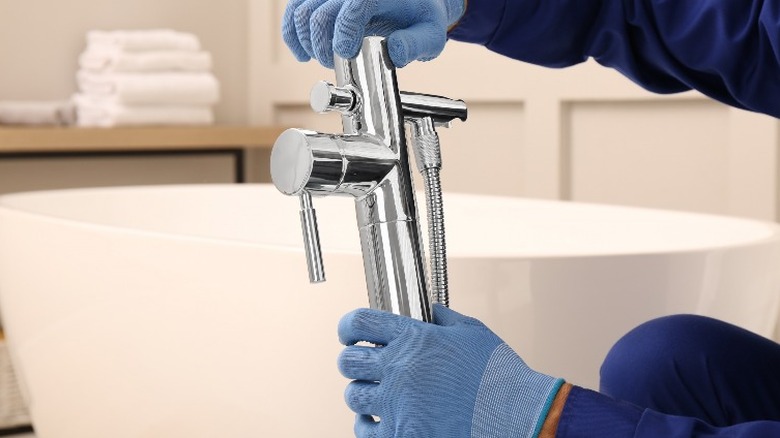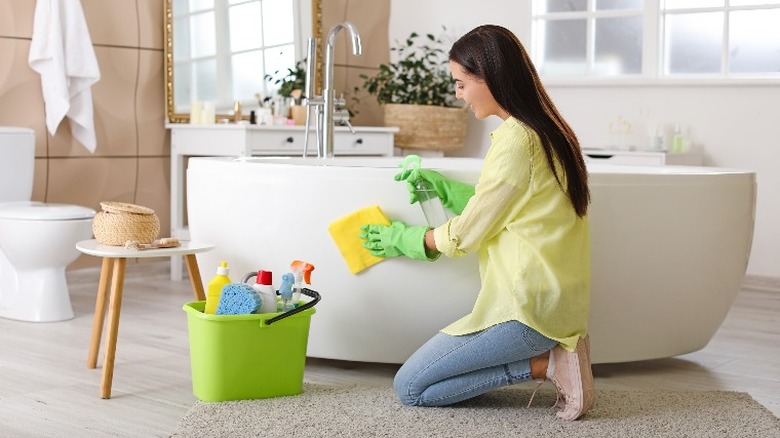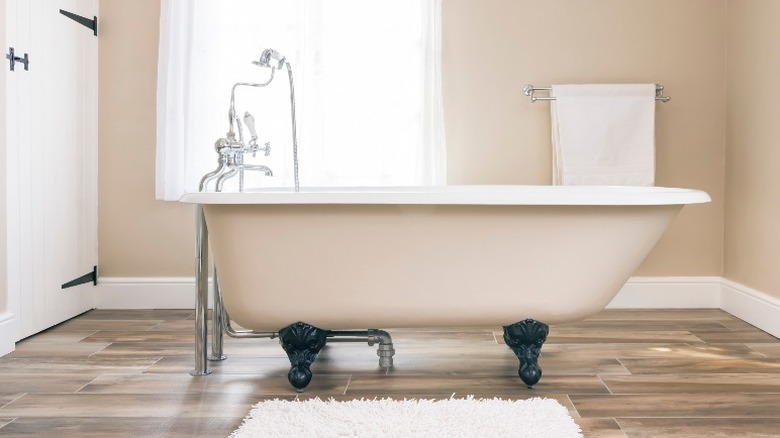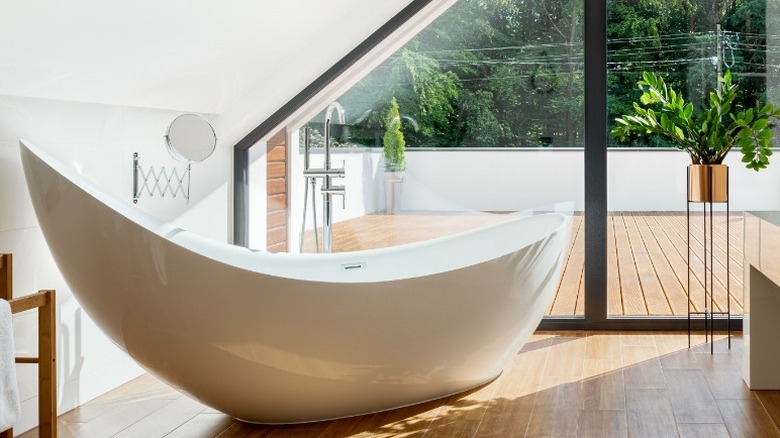Freestanding Bathtubs Vs. Slipper Bathtubs: What's The Difference?
A well-designed bathroom is a personal sanctuary of peace and quiet, notes Maykke. If you're planning to remodel your bathroom in the near future, you may be considering installing a freestanding bathtub. According to JP Spas, freestanding tubs are experiencing a surge in popularity due to their beautiful nature, comfort, and functionality.
Freestanding bathtubs can be the centerpiece of a bathroom, and since they aren't connected to any walls, they can often make a space feel bigger. Additionally, hundreds of different styles are available, from ultra-modern, minimalist tubs for contemporary designs to antique and retro-inspired tubs for traditional bathrooms.
The slipper bathtub is a specific type of freestanding tub, so named due to its distinct shape. Sanctuary Bathrooms notes that slipper tubs are ergonomically shaped because one side sits lower than the other, perfect for relaxing and providing support for your head, neck, and back. Most traditional slipper bathtubs have rolled edges and clawfoot legs, making them a great choice for victorian-style bathrooms. However, more modern, contemporary versions can often be floor mounted and feature sleek, minimalist styling, designer elements, and bold silhouettes.
How they differ in appearance
The slipper bathtub was first introduced during the Victorian era and was named a slipper tub because it resembles a slipper or shoe, stated Signature Hardware. Slipper bathtubs became popular in public bathhouses since the raised backrest would shield bathers from view, offering a greater degree of privacy. Modern variants on the slipper bathtub include double-ended slipper tubs, which are large enough for two occupants, floor-mounted or pedestal slipper tubs, which suit modern bathrooms, and spa slipper tubs that incorporate relaxing air or water jets.
Any kind of bathtub that is uniform in height and open on all sides is referred to as a freestanding tub. While you may think that the only difference between a freestanding and a slipper bathtub is the shape of the back, there are a few more things to consider before deciding which one will suit your bathroom the best.
Pros and cons of a freestanding bathtub
Before we delve into the specific differences in design and functionality, there are several things to think about if you want to install a freestanding bathtub, be it slipper-shaped or otherwise. First and foremost is the amount of room required for a freestanding tub. Alcove, or built-in bathtubs, which are usually installed tight to a wall or in a corner, were initially designed to save space, whereas freestanding tubs are exactly the opposite. Pelham & White suggest that at a bare minimum, you need at least 6 inches from a wall on all sides to allow for cleaning, and if you intend to walk around the bath, then you will obviously need much more.
Additionally, if you are a shower person, freestanding tubs are notoriously difficult to keep water-tight. Remodelista noted that freestanding tubs are designed for soaking, and while it is possible to install a shower over a freestanding bathtub, the options to prevent splashes and water damage are somewhat limited. Some companies sell shower curtains and rails to fit non-standard baths, but the results could be less than ideal and may potentially ruin the elegant look you are trying to achieve.
Choosing the right size
Once you have decided that a freestanding tub is the right choice for you, the next step is to think about the size of tub needed. Signature Hardware explained that due to the unique nature of freestanding tubs, they can be installed in almost any place in the bathroom, allowing them to be the focal point. Although it's ultimately a matter of personal taste, you want your new bath to be in proportion to the room, as a bathtub that is too big will dominate the room and make it look overcrowded.
With the notable exception of double-ended tubs, slipper bathtubs tend to be the most compact version of all freestanding styles. Qualitybath.com stated that the shortest slipper baths can be a mere 30 inches in length and 19 inches wide, which is good to know if space is an issue. On the other hand, if you have the room to accommodate one, bathroom designer C.P. Heart recommends several large freestanding tubs that start at 72 inches in length and 30 inches in width.
Comfort
With the wide array of slipper and freestanding bathtubs available, it's difficult to say which one is the most comfortable. However, High Shower stated that baths with an oval or rounded back are amongst the most comfortable type of freestanding baths available. Slipper bathtubs have the added advantage of a high backrest on one side which also supports the head and neck, which is great for those who prefer a long soak or those who enjoy reading in the bath.
Family Handyman pointed out that for the ultimate luxury, double-ended tubs are sloped and rounded at both ends, which not only provides a symmetric and balanced design element but also allows two people to bathe in comfort at the same time. Double-ended tubs are available in both freestanding and slipper styles and in a range of sizes and materials.
Installation difficulty
As noted by Hunker, freestanding and slipper tubs are both relatively easy to install and may not require a plumber. In most cases, the only major considerations are ensuring the tub is level and connecting the wastewater outlet. If you are replacing an existing tub, this may require some alterations to the pipework, as most freestanding tubs have a centrally located drain rather than at one end.
Traditionally styled slipper tubs are often made from cast iron and can be extremely heavy, especially when filled with water, pointed out Qualitybaths.com. This may mean you will need to reinforce the floor to make it strong enough to carry the additional weight. Conversely, if this sounds too complex, many modern designs of freestanding tubs can be made from acrylic, stainless steel, or even copper, which are much lighter.
Durability and maintenance
The level of durability and amount of maintenance a bathtub needs is predominantly based on the construction material rather than the style. As mentioned, traditional bathtubs are often made from heavy-duty cast iron, which according to Long Home Products, has a long lifespan and a better than average ability to retain heat. Cast iron also requires very little upkeep and, in general, only needs weekly cleaning with soapy water and a soft sponge.
Modern freestanding tubs, on the other hand, are usually made from acrylic. A downside to acrylic bathtubs is that these tubs are more prone to staining, meaning they need to be treated carefully and cleaned more frequently. However, acrylic tubs are up to four times cheaper and are much easier to repair should accidental damage occur.
What about faucets?
As opposed to alcove bathtubs, where the faucets are usually mounted directly on the tub's rim, HGTV explains that freestanding tubs either have a roll-top rim or are completely rimless. This means that the faucets should be either wall-mounted (if the bath is close enough) or come out of the floor with exposed pipes. There are many different designs and finishes of wall and floor-mount faucets to suit either modern or traditional bathrooms and tubs.
One of the best things about floor-mounted faucets is that they can be positioned wherever you like around the bath, which as Build.com notes, can further elevate the aesthetic of a freestanding tub. Commonly, with slipper bathtubs, the faucet is located at the opposite end to the backrest. The faucet is ideally installed in the center or wherever it fits with freestanding tubs, which are usually symmetrical in design.
Is there a difference in cost?
Freestanding bathtubs have a higher price tag than regular built-in bathtubs, according to Laurysen Kitchens, due to their complex designs and materials. Acrylic freestanding tubs tend to be the cheapest option; however, for those looking for something that will make a design statement, The Bathtubber suggests some exciting alternatives such as stone, copper, or a natural mineral composite.
Early Experts suggest that the cost of a tub will depend on its size, style, make, and material, with most ranging from $150 to $2,300 or more. In addition, if you decide to have the tub professionally installed, this can add a further $2,500 on average.
